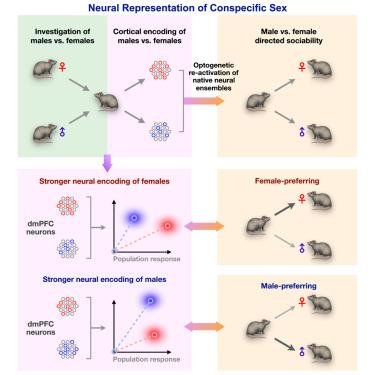Neuron ( IF 14.7 ) Pub Date : 2020-07-13 , DOI: 10.1016/j.neuron.2020.06.020 Lyle Kingsbury 1 , Shan Huang 1 , Tara Raam 1 , Letizia S Ye 1 , Don Wei 1 , Rongfeng K Hu 1 , Li Ye 2 , Weizhe Hong 1

|
A central question related to virtually all social decisions is how animals integrate sex-specific cues from conspecifics. Using microendoscopic calcium imaging in mice, we find that sex information is represented in the dorsal medial prefrontal cortex (dmPFC) across excitatory and inhibitory neurons. These cells form a distributed code that differentiates the sex of conspecifics and is strengthened with social experience. While males and females both represent sex in the dmPFC, male mice show stronger encoding of female cues, and the relative strength of these sex representations predicts sex preference behavior. Using activity-dependent optogenetic manipulations of natively active ensembles, we further show that these specific representations modulate preference behavior toward males and females. Together, these results define a functional role for native representations of sex in shaping social behavior and reveal a neural mechanism underlying male- versus female-directed sociality.
中文翻译:

同种性别的皮质表征塑造社会行为。
几乎与所有社会决策相关的一个核心问题是动物如何整合来自同种动物的性别特异性线索。通过对小鼠进行显微内窥镜钙成像,我们发现性别信息在兴奋性和抑制性神经元的背侧内侧前额叶皮层(dmPFC)中得到体现。这些细胞形成了一种分布式代码,可以区分同种动物的性别,并通过社会经验得到加强。虽然雄性和雌性在 dmPFC 中都代表性别,但雄性小鼠表现出更强的女性线索编码,这些性别表征的相对强度可以预测性别偏好行为。通过对本地活跃群体进行依赖于活动的光遗传学操作,我们进一步表明这些特定的表征可以调节对男性和女性的偏好行为。总之,这些结果定义了性别的原生表征在塑造社会行为中的功能作用,并揭示了男性与女性主导的社会性背后的神经机制。











































 京公网安备 11010802027423号
京公网安备 11010802027423号